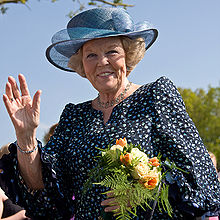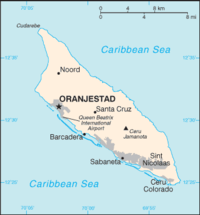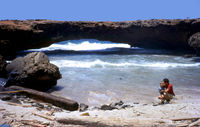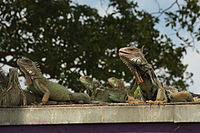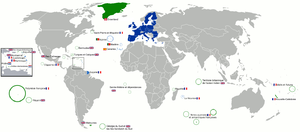- Aruba
-
Aruba 

Flag Coat of arms Anthem: "Aruba Dushi Tera" 
Capital
(and largest city)Oranjestad
12°31′N 70°1′W / 12.517°N 70.017°WOfficial language(s) Dutch, Papiamento[1] Demonym Aruban Government Constitutional monarchy - Monarch Queen Beatrix - Governor Fredis Refunjol - Prime Minister Mike Eman Legislature Estates of Aruba Autonomy from Netherlands Antilles - Date 1 January 1986 Area - Total 178.91 km2
69 sq mi- Water (%) negligible Population - September 2010 estimate 101,484 (Census) - Density 567/km2
1,470/sq miGDP (PPP) 2007 estimate - Total $2.400 billion (182nd) - Per capita $23,831 (32nd) Currency Aruban florin ( AWG)Time zone AST (UTC-04) Drives on the right ISO 3166 code AW Internet TLD .aw Calling code 297 Aruba (
 /əˈruːbə/ ə-roo-bə, Dutch pronunciation: [aˈruba]) is a 33 km-long island of the Lesser Antilles in the southern Caribbean Sea, located 27 km north of the coast of Venezuela and 130 km (aprox.) east of Guajira Peninsula (Colombia). Together with Bonaire and Curaçao, it forms a group referred to as the ABC islands of the Leeward Antilles, the southern island chain of the Lesser Antilles.
/əˈruːbə/ ə-roo-bə, Dutch pronunciation: [aˈruba]) is a 33 km-long island of the Lesser Antilles in the southern Caribbean Sea, located 27 km north of the coast of Venezuela and 130 km (aprox.) east of Guajira Peninsula (Colombia). Together with Bonaire and Curaçao, it forms a group referred to as the ABC islands of the Leeward Antilles, the southern island chain of the Lesser Antilles.Aruba is one of the four constituent countries that form the Kingdom of the Netherlands, together with the Netherlands, Curaçao, and Sint Maarten whose citizens share a single nationality: Dutch citizen. Aruba has no administrative subdivisions, but for census purposes is divided into 8 regions. Its capital is Oranjestad. Unlike much of the Caribbean region, Aruba has a dry climate and an arid, cactus-strewn landscape. This climate has helped tourism as visitors to the island can reliably expect warm, sunny weather. It has a land area of 179 square kilometres (69 sq mi) and is densely populated with a total of 101,484 inhabitants at the 2010 Census. It lies outside the hurricane belt.
Contents
History
Main article: History of ArubaAruba's first inhabitants are thought to have been Caquetíos Amerinds from the Arawak tribe, who migrated there from Venezuela to escape attacks by the Caribs. Fragments of the earliest known Indian settlements date back to 1000 AD. Sea currents made canoe travel to other Caribbean islands difficult, thus Caquetio culture remained closer to that of mainland South America.
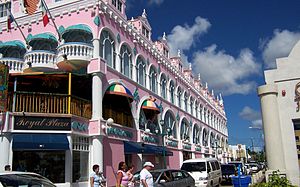 The capital Oranjestad
The capital Oranjestad
Europeans first learned of Aruba following the explorations of Amerigo Vespucci and Alonso de Ojeda in the summer of 1499. Though Vespucci boasted of discovering the island, he and Ojeda were likely guided there by natives of nearby islands. Both described Aruba as an "island of giants," remarking on the comparatively large stature of the native Caquetíos compared to Europeans. Ojeda also referred to the island as "Oro Hubo," Spanish for "It Had Gold." Gold was not discovered on Aruba, however, for another 300 years. Vespucci returned to Spain with stocks of cotton and brazilwood from the island and described houses built into the ocean. Vespucci and Ojeda's tales spurred interest in Aruba and Spaniards soon colonized the island.[2][3]
Aruba was colonized by Spain for over a century. The Cacique or Indian Chief in Aruba, Simas, welcomed the first priests in Aruba and received from them a wooden cross as a gift. In 1508, Alonso de Ojeda was appointed as Spain's first Governor of Aruba, as part of "Nueva Andalucía."
Another governor appointed by Spain was Juan Martinez de Ampíes. A "cédula real" decreed in November 1525 gave Ampíes, factor of Española, the right to repopulate the depopulated islands of Aruba, Curaçao and Bonaire.
In 1528, Ampíes was replaced by a representative of the "House of Welser". Aruba has been under Dutch administration since 1636, initially under Peter Stuyvesant. Stuyvesant was on a special mission in Aruba in November and December 1642. Under the Dutch W.I.C. administration, as "New Netherland and Curaçao" from 1648 to 1664 and the Dutch government regulations of 1629, also applied in Aruba. The Dutch administration appointed an Irishman as "Commandeur" in Aruba in 1667.
In August 1806, General Francisco de Miranda and a group of 200 freedom fighters on their voyage to liberate Venezuela from Spain stayed in Aruba for several weeks.
In 1933 Aruba sent its first petition for Aruba's separate status and autonomy to the Queen.
During World War II, together with Curaçao, the then world-class exporting oil refineries were the main suppliers of refined products to the Allies. Aruba became a British protectorate from 1940 to 1942 and a US protectorate from 1942 to 1945. On February 16, 1942, its oil processing refinery was attacked by a German submarine (U-156) under the command of Werner Hartenstein, but the mission failed. U-156 was later (8 March 1943) destroyed by a US plane as the crew was sunbathing.[4] In March 1944, Eleanor Roosevelt briefly visited American troops stationed in Aruba. In attendance were: His Excellency, Dr. P. Kasteel, the Governor of Curaçao, and his aide, Lieutenant Ivan Lansberg; Rear Admiral T. E. Chandler and his Aide, Lieutenant W. L. Edgington; Captain Jhr. W. Boreel and his aide, Lieutenant E. O. Holmberg; and the Netherlands aide to Mrs. Roosevelt, Lieutenant Commander v.d. Schatte Olivier.
The island's economy has been dominated by five main industries: gold mining, phosphate mining (The Aruba Phosphaat Maatschappij), aloe export, petroleum refineries (The Lago Oil & Transport Company and the Arend Petroleum Maatschappij Shell Co.), and tourism.
Politics
Main article: Politics of Aruba Parliament of Aruba in Oranjestad.
Parliament of Aruba in Oranjestad.
As a constituent country of the Kingdom of the Netherlands, Aruba's politics take place within a framework of a 21-member Parliament and an eight-member Cabinet. The governor of Aruba is appointed for a six-year term by the monarch, and the prime minister and deputy prime minister are elected by the Staten (or "Parlamento") for four-year terms. The Staten is made up of 21 members elected by direct, popular vote to serve a four-year term.[5]
Together with the Netherlands, the countries of Aruba, Curaçao and Sint Maarten form the Kingdom of the Netherlands. As they share the same Dutch citizenship, these four countries still also share the Dutch passport as the Kingdom of the Netherlands passport. As Aruba, Curaçao and Sint Maarten have small populations, the three countries had to limit immigration. To protect their population, they have the right to control the admission of people from the Netherlands. There is the supervision of the admission and expulsion of people from the Netherlands and the setting of general conditions for the admission and expulsion of aliens.
Aruba is designated as a member of the Overseas Countries and Territories (OCT) and is thus officially not a part of the European Union, though Aruba can and does receive support from the European Development Fund.[6][7]
Moves towards independence
In August 1947, Aruba presented its first "Staatsreglement" (constitution), for Aruba's "status aparte" as the status of an autonomous state within the Kingdom of the Netherlands. By 1954, the Charter of the Kingdom of the Netherlands was established, providing a framework for relations between Aruba and the rest of the Kingdom.[8]
In 1972, at a conference in Suriname, Betico Croes (MEP) proposed a "sui-generis" Dutch Commonwealth of four states: Aruba, the Netherlands, Suriname and the Netherlands Antilles, each with its own nationality. Mr. C. Yarzagaray, a parliamentary member representing the AVP political party, proposed a referendum for the people of Aruba to determine Aruba's separate status or "Status Aparte" as a full autonomous state under the crown. He proclaimed: "Aruba shall never accept a federation and a second class nationality."[citation needed]
Betico Croes worked in Aruba to inform and prepare the people of Aruba for independence. In 1976, a committee appointed by Croes introduced the national flag and anthem as the symbols of Aruba's sovereignty and independence, and he also set 1981 as a target for Aruba's independence. In March 1977, the first Referendum for Self Determination was held with the support of the United Nations and 82% of the participants voted for independence.[citation needed]
The Island Government of Aruba assigned the Institute of Social Studies in The Hague to prepare a study of Aruba's independence, which was published in 1978, titled "Aruba en Onafhankelijkheid, achtergronden, modaliteiten en mogelijkheden; een rapport in eerste aanleg". At the conference in The Hague in 1981, Aruba's independence was set for the year 1991.
In March 1983 Aruba finally reached an official agreement within the Kingdom for Aruba's Independence, which would occur in a series of steps granting increasing autonomy. in August 1985 Aruba drafted a constitution that was unanimously approved. On 1 January 1986, after elections were held for Aruba's first parliament, Aruba seceded from the Netherlands Antilles and officially became a country of the Kingdom of the Netherlands. Full independence was set for 1996.
This achievement is largely due to Betico Croes and the political support of other nations like the USA, Panama, Venezuela and various European countries.[citation needed] Croes was later proclaimed "Libertador di Aruba" after his death in 1986. In 1990, movement toward independence was postponed upon the request of Aruba's Prime Minister, Nelson O. Oduber. The article scheduling Aruba's complete independence was rescinded in 1995, although the process can begin again after a referendum.
Law
The Aruban legal system is based on the Dutch model. Instead of juries or grand juries, in Aruba, legal jurisdiction lies with a Gerecht in Eerste Aanleg (Court of First Instance) on Aruba, a Gemeenschappelijk Hof van Justitie voor de Nederlandse Antillen en Aruba (Common Court of Justice of the Netherlands Antilles and Aruba) and the Hoge Raad der Nederlanden (Supreme Court of Justice of the Netherlands).[9] The Korps Politie Aruba (Aruba Police Force) is the island's law enforcement agency and operates district precincts in Oranjestad, Noord, San Nicolaas, and Santa Cruz, where it is headquartered.[10]
Education
Aruba's educational system is patterned after the Dutch system of education. There are 68 schools for primary education, 12 schools for secondary education, and 5 universities in Aruba.[citation needed] In 2007, there were 22,930 registered full-time students.[citation needed]
The Government of Aruba finances the national education system, except for private schools, such as the International School of Aruba (ISA), which finance their own activities. The percentage of money earmarked for education is higher than the average for the Caribbean/Latin American region.[citation needed]
Arubans benefit from a strong primary school education. A segmented secondary school program includes vocational training, basic education, college preparation and advanced placement.
Higher education goals can be pursued through the Professional Education program (EPI), the teachers college (IPA) as well as through the University of Aruba (UA) which offers bachelors and masters programs in law, finance and economics and hospitality and tourism management. Since the choice for higher education on the island itself is limited, many students choose study in the Netherlands, or abroad in countries in North America, South America as well as the rest of Europe.
Aruba is also home to two medical schools: Aureus University School of Medicine and Xavier University School of Medicine.
Geography
Main article: Geography of ArubaAruba is a generally flat, riverless island in the Leeward Antilles island arc of the Lesser Antilles. Aruba is widely known for its white sandy beaches on the western and southern coasts of the island, relatively sheltered from fierce ocean currents, and this is where most tourist development has taken place. The northern and eastern coasts, lacking this protection, are considerably more battered by the sea and have been left largely untouched by humans. The hinterland of the island features some rolling hills, the best known of which are called Hooiberg at 165 meters (541 ft) and Mount Jamanota, the highest on the island at 188 meters (617 ft) above sea level. Oranjestad, the capital, is located at 12°19′N 70°1′W / 12.317°N 70.017°W.
To the east of Aruba are Bonaire and Curaçao, two island territories which once formed the southwest part of the Netherlands Antilles; this group of islands is sometimes called the ABC islands.
Climate
Main article: Climate of ArubaThe isothermal temperature of Aruba's tropical marine climate attracts tourists to the island all year round. In the Köppen climate classification, Aruba features a semi-arid climate (BSh). However Aruba does not get quite as hot as other locations with a BSh climate. Temperature varies little from 28 °C (82.4 °F), moderated by constant trade winds from the Atlantic Ocean. Yearly precipitation barely exceeds 400 mm (15.7 in).
Climate data for Oranjestad, Aruba Month Jan Feb Mar Apr May Jun Jul Aug Sep Oct Nov Dec Year Record high °C (°F) 32
(90)33
(91)34
(93)34
(94)34
(94)35
(95)34
(94)36
(96)36
(96)35
(95)33
(92)33
(92)36
(96)Average high °C (°F) 30
(86)31
(87)31
(88)31
(88)32
(89)32
(90)32
(89)32
(90)33
(91)32
(90)32
(90)31
(87){{{year high C}}}
(89)Daily mean °C (°F) 27
(80)27
(80)27
(80)27
(81)28
(83)28
(83)28
(83)29
(84)29
(84)28
(83)28
(82)27
(80){{{year mean C}}}
(82)Average low °C (°F) 24
(76)24
(76)24
(76)26
(78)26
(79)27
(80)26
(79)27
(80)27
(80)26
(79)26
(78)24
(76){{{year low C}}}
(78)Record low °C (°F) 19
(66)21
(69)21
(70)22
(71)22
(71)23
(73)21
(70)21
(70)22
(72)22
(71)22
(72)21
(69)19
(66)Precipitation mm (inches) 38.1
(1.50)19.1
(0.75)7.6
(0.30)13.2
(0.52)13.7
(0.54)17.8
(0.70)30.5
(1.20)25.4
(1.00)35.3
(1.39)65
(2.56)78.7
(3.10)65.8
(2.59)408.9
(16.10)Source: http://www.arubabound.com/weather/average.htm [11] Economy
Iguanas on a rooftop in Aruba. Main article: Economy of Aruba
Main article: Economy of ArubaAruba enjoys one of the highest standards of living in the Caribbean region including a low unemployment rate. About three quarters of the Aruban gross national product is earned through tourism or related activities. Most tourists are from Venezuela and the United States (predominantly from eastern and southern states). Before the "Status Aparte" (a separate completely autonomous country/state within the Kingdom), oil processing was the dominant industry in Aruba despite expansion of the tourism sector. Today, the influence of the oil processing business is minimal. The size of the agriculture and manufacturing sectors also remains minimal.
The GDP per capita for Aruba was estimated to be $21,800 in 2004; among the highest in the Caribbean and the Americas.[12] Its main trading partners are Venezuela, the United States and the Netherlands.
Deficit spending has been a staple in Aruba's history, and modestly high inflation has been present as well. As of 2006, the government's debt had grown to 1.883 billion Aruban florins.[13] Aruba received some development aid from the Dutch government each year through 2009, as part of a deal (signed as "Aruba's Financial Independence") in which the Netherlands gradually reduced its financial help to the island each successive year. The exchange rate of the Aruban florin has remained steady in recent years at 1.79 florins to 1 U.S. dollar.[12]
In 2006 the Aruban government has also changed several tax laws to further reduce the deficit. Direct taxes have been converted to indirect taxes as proposed by the IMF. A 3% tax has been introduced on sales and services, while income taxes have been lowered and revenue taxes for business reduced by 20%. The government compensated workers with 3.1% for the effect that the B.B.O. would have on the inflation for 2007. The inflation on Aruba in 2007 was 8.7%.
Demographics
 Population of Aruba according to the FAO in 2005; number of inhabitants given in thousands.
Population of Aruba according to the FAO in 2005; number of inhabitants given in thousands. Main article: Demographics of Aruba
Main article: Demographics of ArubaAruba is situated in the deep southern part of the Caribbean. Because it has almost no rainfall, Aruba was saved from the plantation system and the economics of the slave trade.
Aruba's population is estimated to be 80% mestizo and 20% other ethnicities. Arawaks spoke the "broken Spanish" which their ancestors had learned on Hispaniola. The Dutch took control 135 years after the Spanish, left the Arawaks to farm and graze livestock, and used the island as a source of meat for other Dutch possessions in the Caribbean, leading to a depletion of the Arawak population. The Arawak heritage is stronger on Aruba than on most Caribbean islands. Although no full-blooded Aboriginals remain, the features of the islanders clearly indicate their genetic Arawak heritage. Most of the population is descended mostly from Arawak, and to a lesser extent Spanish, Italian, Dutch, and a few French, Portuguese, British, and African ancestors.
Recently there has been substantial immigration to the island from neighboring American and Caribbean nations, possibly attracted by the higher paid jobs. In 2007, new immigration laws were introduced to help control the growth of the population by restricting foreign workers to a maximum of 3 years residency on the island.
Demographically, Aruba has felt the impact of its proximity to Venezuela, far more so than neighboring Curaçao and Bonaire. Much of Aruba's families are present by way of Venezuela and there is a seasonal increase of Venezuelans living in second homes.
Regions
For census purposes, Aruba is divided into 8 regions, which have no administrative functions:
Name Area (km²) Population
1991 CensusPopulation
2000 CensusPopulation
2010 CensusNoord / Tanki Leendert 34.62 10,056 16,944 21,495 Oranjestad West 9.29 8,779 12,131 13,976 Oranjestad Oost 12.88 11,266 14,224 14,318 Paradera 20.49 6,189 9,037 12,024 San Nicolas Noord 23.19 8,206 10,118 10,433 San Nicolas Zuid 9.64 5,304 5,730 4,850 Santa Cruz 41.04 9,587 12,326 12,870 Savaneta 27.76 7,273 9,996 11,518 Total Aruba 178.91 66,687 90,506 101,484 Cities and towns
Main article: List of cities in ArubaThe island, with a population of just over 100,000 inhabitants, does not have major cities.
- Oranjestad (33,000 in 2006)
- Paradera
- San Nicolas
- Noord
- Santa Cruz
- Savaneta
Culture
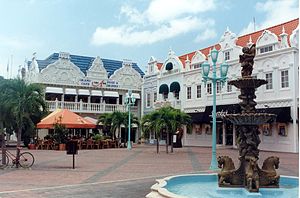 Ornate buildings in Oranjestad, Aruba.
Ornate buildings in Oranjestad, Aruba.
On March 18 Aruba celebrates its National Day. In 1976, Aruba presented its National Anthem (Aruba Dushi Tera) and Flag.
Main article: Culture of ArubaThe origins of the population and location of the island give Aruba a mixed culture. According to the Bureau Burgelijke Stand en Bevolkingsregister (BBSB), as of 2005 there are ninety-two different nationalities living on the island. Dutch influence can still be seen, as in the celebration of "Sinterklaas" on December 5 and 6 and other national holidays like April 30, when in Aruba and the rest of the Kingdom of the Netherlands the Queen's birthday or "Dia di La Reina" (Koninginnedag) is celebrated. Christmas and New Year are celebrated with the typical music and songs of gaitas for Christmas and the Dande for New Year, and the "ayaca", the "ponche crema" and "ham", and other typical foods and drinks. Millions of dollars worth of fireworks are burnt at midnight on New Year's. On January 25, Betico Croes' birthday is celebrated. In June there is the celebration of the "Dia di San Juan", with the song of "Dera Gai". Religion also has its influences; the days of Ascension and Good Friday are also two holidays on the island.
The holiday of Carnival is also an important one in Aruba, as it is in many Caribbean and Latin American countries, and, like Mardi Gras, that goes on for weeks. Its celebration in Aruba started, around the 1950s, influenced by the inhabitants from the nearby islands (Venezuela, St Vincent, Trinidad, Barbados, St. Maarten and Anguilla) who came to work for the Oil refinery. Over the years the Carnival Celebration has changed and now starts from the beginning of January till the Tuesday before Ash Wednesday with a large parade on the last Sunday of the festivities (Sunday before Ash Wednesday).
Tourism from the United States has recently increased the visibility of American culture on the island, with such celebrations as Halloween and Thanksgiving Day in November.
Language
Main article: Languages of ArubaLanguage can be seen as an important part of island culture in Aruba. The official languages are Dutch and – since 2003 – Papiamento. Papiamento is the predominant language on Aruba. A creole language spoken on Aruba, Bonaire, and Curaçao, it incorporates words from other languages including Portuguese, West African languages, Dutch, and Spanish. Like many islands in the region, Spanish is also often spoken. English has historical connections (with the British Empire) and is known by many; English usage has also grown due to tourism. Other common languages spoken based on the size of their community are Portuguese, Chinese, German and French. The latter is offered in high school and college, since a high percentage of Aruban students continue their studies in Europe.
In recent years, the government of Aruba has shown an increased interest in acknowledging the cultural and historical importance of its native language. Although spoken Papiamento is fairly similar among the several Papiamento-speaking islands, there is a big difference in written Papiamento. The orthography differs per island and even per group of people. Some are more oriented towards the Portuguese roots and use the equivalent spelling (e.g. "y" instead of "j"), where others are more oriented towards the Dutch roots.
In a book The Buccaneers of America, first published in 1678, it is stated by eyewitness account that the Indians on Aruba spoke "Spanish". The oldest government official statement written in Papiamento dates from 1803.
Aruba has four newspapers published in Papiamento: Diario, Bon Dia, Solo di Pueblo and Awe Mainta and two in English : Aruba Today and The News. Amigoe is the newspaper published in Dutch. Aruba also has 18 radio stations (2 AM and 16 FM) and three local television stations (Tele-Aruba, Aruba Broadcast Company and Channel 22).
Infrastructure
Aruba's Queen Beatrix International Airport is located near Oranjestad. This airport has daily flights to various cities across the United States, to San Juan, Puerto Rico; Miami, Florida; Chicago, Illinois; Philadelphia and Pittsburgh Pennsylvania; Houston, Texas; Atlanta, Georgia; Charlotte, North Carolina; Washington DC; New York City; and Boston, Massachusetts. It also connects Aruba with Toronto, Ontario, and South America, with daily flights to the international airports of Venezuela, Colombia, Peru, Brazil, Germany, France, Spain, U.K and most of Europe through the Schiphol Airport in the Netherlands. Direct flights from Italy started in November 2008.
According to the Aruba Airport Authority, almost 1.7 million travelers used the airport in 2005, of which 61% were Americans.
In cooperation with the United States government, and for the facilitation for the passengers that arrive into the United States, the United States Department of Homeland Security (DHS), U.S. Customs and Border Protection (CBP) full pre-clearance facility in Aruba has been in effect since February 1, 2001 with the expansion in the Queen Beatrix Airport, United States and Aruba have the agreement since 1986 that begins as a USDA and Customs post, and since 2008, the only island to have this service for private flights. In 1999, the U.S. Department of Defense established a Forward Operating Location (FOL) at the airport.
Aruba has two ports, Barcadera and Playa, which are located in Oranjestad. The Port of Playa welcomes all the cruise-ship lines, including Royal Caribbean, Carnival Cruise Lines, NCL, Holland America Line, Disney Cruise Line and many more; an estimated almost one million tourists enter in this port per year, Aruba Ports Authority, owned and operated by the Aruban government is the authority in these seaports.
Aruba's public buses transportation services is in charge of Arubus, a government based company which operates from 3:30am until 12:30am 365 days a year. Small private vans also provide the transportation services in certain areas such Hotel Area, San Nicolaas, Santa Cruz and Noord.
Aruba also counts two telecommunications providers, Setar the government based company and Digicel Irish ownership company based in Kingston, Jamaica. Setar is the provider of services such as Internet, video conference, GSM wireless tech and land lines and offer the latest in telecom services, Digicel is the Setar competitor in wireless technology using the GSM platform.
Utilities on the island
Water-en Energiebedrijf (W.E.B.) Aruba NV produces potable industrial water, at the world's third largest desalination plant.[14] Average daily consumption in is about 37,000 metric tons.[15]
Places of interest
- Hooiberg
- Lourdes Grotto
- Natural Bridge, Aruba*
- Natural Pool
- Palm Beach, Aruba
- Quadiriki Caves
- Tierra Del Sol Golf Course
- Eagle Beach
- Arashi, Aruba
- Caves of Aruba
- Baby Beach, Aruba
- Aruba Aloe Factory
- Palm Island, Aruba
- Sint Nicolaas, Aruba
* Collapsed September 2, 2005 [16]
Notable Arubans
- Dave Benton, musician who won the 2001 Eurovision Song Contest representing Estonia
- Juan Chabaya Lampe, Composer of Aruba's national anthem
- Henny Eman, politician
- Albert (Shon A) Eman, politician
- Juan Enrique Yrausquin, politician
- Betico Croes, politician
- Mike Eman, current Prime-Minister Cabinet Mike Eman 1
- Bobby Farrell, musician (group Boney M.)
- Percy Irausquin, fashion designer
- Jim Jones, American hip-hop artist
- Gene Kingsale, former MLB player
- Calvin Maduro, former MLB player
- Roger Peterson, musician
- Pete Philly, Dutch hip-hop artist
- Sidney Ponson, former MLB player currently a free agent
See also
- Outline of Aruba
- Bibliography of Aruba
- Index of Aruba-related articles
- Caribbean Sea
- Kingdom of the Netherlands
- Leeward Antilles
- List of Arubans
- SS Pedernales
References
- ^ Migge, Bettina; Léglise, Isabelle; Bartens, Angela (2010). Creoles in Education: An Appraisal of Current Programs and Projects. Amsterdam: John Benjamins Publishing Company. p. 268. ISBN 9789027252586. http://books.google.com/books?id=4SMLb6hKv4YC&lpg=PT276&dq=aruba%20official%20language%20Papiamento&pg=PT276#v=onepage&q=aruba%20official%20language%20Papiamento&f=false.
- ^ Sullivan, Lynne M. (2006). Adventure Guide to Aruba, Bonaire & Curacao. Edison, NJ: Hunter Publishing, Inc.. pp. 57–58. http://books.google.com/books?id=M8SyFOyvjkQC&lpg=PA58&dq=vespucci%20aruba&pg=PA58#v=onepage&q=vespucci%20aruba&f=false.
- ^ Sauer, Carl Ortwin (1966). The Early Spanish Main. Cambridge: Cambridge University Press. p. 112. http://books.google.com/books?id=plzS7SL_-f0C&lpg=PA112&dq=vespucci%20aruba&pg=PR4#v=onepage&q=vespucci%20aruba&f=false.
- ^ [1]
- ^ "Political Stability". Aruba Department of Foreign Affairs. http://www.arubaforeignaffairs.com/afa/readBlob.do?id=694. Retrieved 2011-06-07.
- ^ "EU Relations with Aruba". European Union. http://www.eeas.europa.eu/aruba/index_en.htm. Retrieved 2011-06-06.
- ^ "Overseas Countries and Territories (OCT)". European Union. http://europa.eu/legislation_summaries/development/overseas_countries_territories/index_en.htm. Retrieved 2011-06-06.
- ^ Robbers, Gerhard (2007). Encyclopedia of World Constitutions. 1. New York City: Facts on File, Inc.. p. 649. ISBN 0-8160-6078-9. http://books.google.com/books?id=M3A-xgf1yM4C&lpg=PA649&dq=aruba%20constitution&pg=PR4#v=onepage&q=aruba%20constitution&f=false.
- ^ Aruba.com
- ^ "Korps Politie Aruba: district precincts". Aruba Police Force. http://www.kparuba.com/districts.html. Retrieved 2010-09-11.
- ^ Aruba Bound!. "Aruba Weather". Aruba Bound!. http://www.arubabound.com/weather/average.htm. Retrieved 2011-02-08.
- ^ a b Central Intelligence Agency (2009). "Aruba". The World Factbook. https://www.cia.gov/library/publications/the-world-factbook/geos/aa.html. Retrieved 2011-06-06.
- ^ Central Bureau of Statistics. "Key Indicators General Government, 1997–2006". http://www.cbs.aw/cbs/manageDocument.do?dispatch=view&id=927. Retrieved 2011-06-07.
- ^ Aruba Hosts International Desalination Conference 2007 | Official Travel News from Aruba
- ^ "History". W.E.B. Aruba NV. http://www.webaruba.com/index.php?option=com_content&task=view&id=33&Itemid=123. Retrieved 2011-06-07.
- ^ "Coral bridge, natural Aruba tourist spot, collapses". Associated Press. 2005. http://www.usatoday.com/news/world/2005-09-02-aruba-bridge_x.htm?csp=36. Retrieved 2010-09-11.
External links
- Government of Aruba
- Aruba.com – Official Tourism site of Aruba
- News of Aruba - In English
- Aruba at the Open Directory Project
- Wikimedia Atlas of Aruba
- Aruba travel guide from Wikitravel
Aruba topics Politics and government Coast guard · Coat of arms · Constitution · Elections · Estates (parliament) · Flag · Foreign relations · Governor · Military · Monarch · Police · Political parties · Prime Minister · Visa policyCulture and history Economy and infrastructure Geography and environment Sports See also: Index of Aruba-related articles, Outline of Aruba, Kingdom of the Netherlands, Netherlands AntillesGeographic locale  Aruba2 ·
Aruba2 ·  Bonaire (Klein Bonaire) ·
Bonaire (Klein Bonaire) ·  Curaçao (Klein Curaçao) ·
Curaçao (Klein Curaçao) ·  Saba ·
Saba ·  Sint Eustatius ·
Sint Eustatius ·  Sint Maarten
Sint Maarten
1The Netherlands Antilles was dissolved on 10 October 2010
2Aruba seceded from the Netherlands Antilles on 1 January 1986
Countries and territories of the Caribbean Sovereign states Other republicsDependencies and other areas by parent state United KingdomNetherlandsAruba · Bonaire · Curaçao · Saba · Sint Eustatius · Sint MaartenFranceUnited StatesCountries and dependencies of North America Sovereign states - Antigua and Barbuda
- Bahamas
- Barbados
- Belize
- Canada
- Costa Rica
- Cuba
- Dominica
- Dominican Republic
- El Salvador
- France (Guadeloupe · Martinique)
- Grenada
- Guatemala
- Haiti
- Honduras
- Jamaica
- Mexico
- Nicaragua
- Netherlands (Bonaire · Saba · Sint Eustatius)
- Panama
- St. Kitts and Nevis
- Saint Lucia
- St. Vincent and the Grenadines
- Trinidad and Tobago
- United States
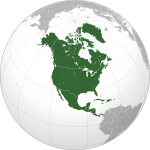
Dependencies DenmarkFranceNetherlands- Aruba
- Curaçao
- Sint Maarten
United KingdomUnited StatesInternational membership and history Nations MembersAntigua and Barbuda · Bahamas1 · Barbados · Belize · Dominica · Grenada · Guyana · Haiti1 · Jamaica · Montserrat2 · St. Kitts and Nevis · St. Lucia · St. Vincent and the Grenadines · Suriname · Trinidad and TobagoAssociate membersObservers
Institutions Related organizations 1 Member of the Community but not of the CARICOM Single Market and Economy (CSME). 2 British overseas territory awaiting entrustment to join the CSME.Outlying territories of European countries Territories under European sovereignty but closer to or on continents other than Europe (see inclusion criteria for further information)Denmark France Italy Netherlands Norway Portugal Spain United
KingdomAnguilla · Bermuda · British Virgin Islands · Cayman Islands · Falkland Islands · Montserrat · Saint Helena, Ascension and Tristan da Cunha · Turks and Caicos Islands · British Antarctic Territory · British Indian Ocean Territory · Pitcairn Islands · South Georgia and the South Sandwich IslandsDutch Empire Colonies and trading posts of the Dutch East India Company (1602-1798) GovernoratesAmbon · Banda · Batavia · Cape Colony · Ceylon · Coromandel · Formosa · Northeast coast of Java · Makassar · Malacca · MoluccasDirectoratesCommandmentsResidenciesSettlements with an opperhoofdColonies and trading posts of the Dutch West India Company (1621-1792) Colonies in the AmericasAcadia · Berbice† · Cayenne · Curaçao and Dependencies · Demerara · Essequibo · Brazil · New Netherland · Pomeroon · Sint Eustatius and Dependencies · Suriname‡ · Tobago · Virgin IslandsTrading posts in Africa† Governed by the Society of Berbice · ‡ Governed by the Society of SurinameSettlements of the Noordsche Compagnie (1614-1642) SettlementsColonies of the Kingdom of the Netherlands (1815-1962) Until 1825Until 1853Until 1872Until 1945Until 1954Until 1962† Became constituent countries of the Kingdom of the Netherlands; Suriname gained full independence in 1975, Curaçao and Dependencies was renamed to the Netherlands Antilles, which was eventually dissolved in 2010.Kingdom of the Netherlands (1954-Present) Constituent countriesPublic bodies of the NetherlandsDependencies of European Union states 
Denmark France United Kingdom Anguilla · Bermuda · British Antarctic Territory · British Indian Ocean Territory · British Virgin Islands · Cayman Islands · Falkland Islands · Gibraltar · Montserrat · Pitcairn Islands · Saint Helena, Ascension and Tristan da Cunha · South Georgia and the South Sandwich Islands · Turks and Caicos IslandsCategories:- Aruba
- Caribbean countries
- Dependent territories in North America
- Kingdom of the Netherlands
- Lesser Antilles
- Islands of the Netherlands Antilles
- Special territories of the European Union
- Dutch-speaking countries
- States and territories established in 1986
- Island countries
- Former Dutch colonies
Wikimedia Foundation. 2010.

